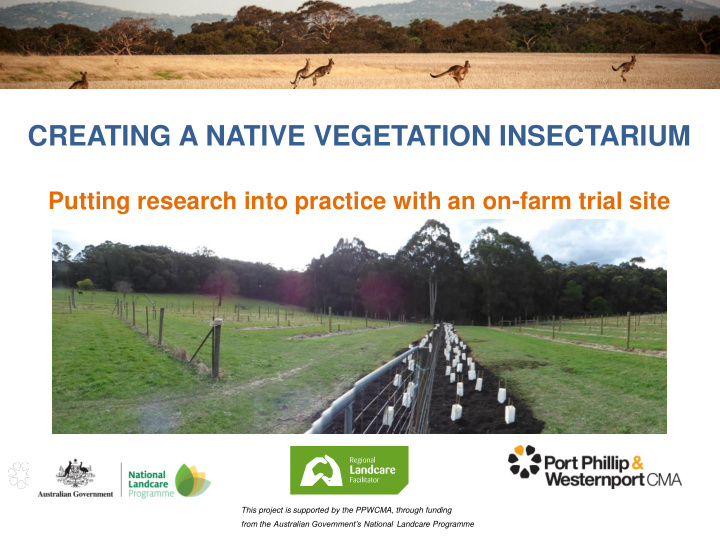



CREATING A NATIVE VEGETATION INSECTARIUM Putting research into practice with an on-farm trial site This project is supported by the PPWCMA, through funding from the Australian Government’s National Landcare Programme
The multiple benefits of insectariums! • Shelterbelt • Habitat and food source for insects • Biodiversity values (consider offsets in planning applications) • Meet obligations in Environmental Assurance programs • Bush Food production This is how I went about setting up an insectarium at Fielderberry Farm
1. Looked up the relevant Ecological Vegetation Class (EVC) for the property Weblink: http://mapshare2.dse.vic.gov.au/MapShare2EXT/imf.jsp?site=bim STEP 3: Select 2005 EVC and allow the map to refresh STEP 2: Select appropriate bioregion, for us this will be either: Gippsland Plain Highlands-Southern Fall Victorian Volcanic Plain
http://vro.agriculture.vic.gov.au/dpi/vro/wgregn.nsf/pages/wg_vegetation_res_evc_descriptions Look for plants which you have seen featured in the research as appropriate insectarium species Quite a few relevant EVC’s have bush foods, you just need to know what you are looking for Plant a mix of EVC plants depending on the layout of your insectarium The more plant diversity and layers, the better the habitat for diverse beneficial insects
• Upper story (shelterbelt)- E. olida • Middle story- (shelterbelt)- Bursaria spinosa, Prostanthera lasianthos • Lower story- grevillea, correa, round leaf mint bush, parrot pea, heath, daisy, honeypots, river mint, lilies etc • Groundcovers- native violet, running postman, pussytails, muntries etc
Grevillea Acacia Heath Kunzea rosmanifolia suevolens pomifera * Native Mentha Themeda Euc olida grasses australis triandra (strawberry gum) * Wallaby, Weeping and Spear)
• Shelterbelt • Habitat and food source for insects • Biodiversity values (consider offsets in planning applications) • Meet obligations in Environmental Assurance programs • Bush Food production Your insectarium layout can be any design you like • Grasses under vine or inter-row, end of row • Surrounding a dam • Land class zone unsuitable for production • Garden beds • Headlands, buffers and re-vegetated shelterbelts It’s about insect corridors and native vegetation connectivity!
How much did it cost? Insectarium Costs- indicative start-up costs for any property EXPENSE ITEM COST CALCULATION COMMENTS based on tubestock prices averaging $2 60m row x 2m wide, some indiegnous nurseries are cheaper, native indigenous plants x380 760 each commerical nurseries more expensive Eucalypt windbreak (optional) x based on tubestock prices averaging $2 some indiegnous nurseries are cheaper, commerical nurseries 10 plants 20 each more expensive tree guards x 380 342based on .90c/tree guard and stakes bulk buy sticky traps x90 34optional for IPM monitoring monitoring Baseline September 1 week x 10 traps. Oct-Jan (4 months). 10 traps over a week x 4 weeks (one IPM monitoring (optional) 1500$30/trap. Optional analysis/month) = 50 traps total IPM monitoring (optional) 360$30/pitfall trap 3 traps in main insectarium $90 each analysis x 4 months snap lock bags & postage for sticky traps 60approx. post to Melb Uni variable depending on product used, amount required, Mulch 200050m3 transport distance and hire of a spreader TOTAL 5076 without IPM monitoring 3216
Recommend
More recommend